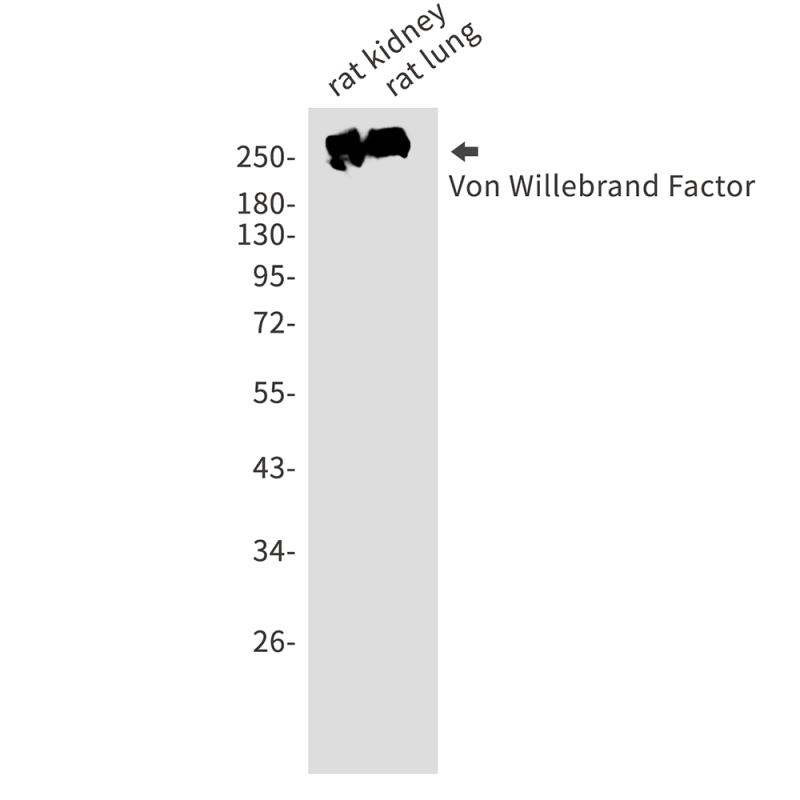
| WB | 1/500-1/1000 | Rat |
| IF | 咨询技术 | Rat |
| IHC | 1/50-1/100 | Rat |
| ICC | 技术咨询 | Rat |
| FCM | 咨询技术 | Rat |
| Elisa | 咨询技术 | Rat |
| Aliases | VWF; von Willebrand factor; von Willebrand antigen II; F8VWF |
| Entrez GeneID | 7450 |
| WB Predicted band size | Calculated MW: 309 kDa; Observed MW: 309 kDa |
| Host/Isotype | Rabbit IgG |
| Antibody Type | Primary antibody |
| Storage | Store at 4°C short term. Aliquot and store at -20°C long term. Avoid freeze/thaw cycles. |
| Species Reactivity | Rat |
| Immunogen | A synthetic peptide of human Von Willebrand Factor |
| Formulation | Purified antibody in TBS with 0.05% sodium azide,0.05%BSA and 50% glycerol. |
+ +
以下是3-4条关于von Willebrand Factor(VWF)抗体的参考文献,简要整理如下:
---
1. **文献名称**: *Caplacizumab for Acquired Thrombotic Thrombocytopenic Purpura*
**作者**: Peyvandi, F., et al.
**摘要**: 该研究报道了一种抗VWF的单克隆抗体(Caplacizumab)用于治疗获得性血栓性血小板减少性紫癜(TTP)的临床试验结果。结果显示,该抗体通过靶向VWF的A1结构域,抑制其与血小板结合,显著改善患者症状并降低死亡率。
---
2. **文献名称**: *Autoantibodies against von Willebrand Factor in Acquired von Willebrand Syndrome*
**作者**: Lenting, P.J., et al.
**摘要**: 研究探讨了获得性血管性血友病综合征(AVWS)中抗VWF自身抗体的病理机制,发现这些抗体通过干扰VWF与凝血因子VIII的结合或促进VWF的清除,导致出血倾向。文中还总结了诊断和免疫抑制治疗的策略。
---
3. **文献名称**: *Anti-VWF Antibodies in Systemic Lupus Erythematosus: Clinical Implications*
**作者**: Scully, M., et al.
**摘要**: 该文献分析了系统性红斑狼疮(SLE)患者体内抗VWF抗体的存在与出血或血栓事件的相关性,指出部分抗体可能通过改变VWF多聚体结构影响其功能,为SLE并发症管理提供了新视角。
---
4. **文献名称**: *Laboratory Testing for von Willebrand Factor Antibodies*
**作者**: De Jong, A., & Eikenboom, J.
**摘要**: 研究比较了ELISA、免疫沉淀法和功能分析法检测抗VWF抗体的敏感性和特异性,强调结合多种方法可提高获得性VWD(血管性血友病)的诊断准确性。
---
以上文献均聚焦于VWF抗体的病理作用、治疗应用或检测技术,涵盖临床和实验研究。如需具体文章链接或发表年份,可进一步补充说明。
Von Willebrand Factor (VWF) antibodies are autoantibodies or alloantibodies that target VWF, a critical glycoprotein in hemostasis. VWF facilitates platelet adhesion at injury sites and stabilizes coagulation factor VIII. Antibodies against VWF are rare but clinically significant, often leading to acquired von Willebrand syndrome (aVWS), characterized by bleeding symptoms like mucocutaneous hemorrhage or postoperative bleeding. These antibodies arise through two main pathways: **autoimmune mechanisms** (autoantibodies) or **immune responses to exogenous VWF** (alloantibodies). Autoantibodies are associated with autoimmune disorders (e.g., systemic lupus erythematosus), lymphoproliferative diseases, or solid tumors, while alloantibodies develop in patients with inherited von Willebrand disease (VWD) after exposure to VWF-containing therapies.
Antibodies impair VWF function by accelerating its clearance or blocking interactions with platelets/factor VIII. Diagnosis involves mixing studies, ELISA, or immunoprecipitation to detect inhibitory activity. Management focuses on controlling bleeding (e.g., recombinant factor VIII, desmopressin) and addressing the underlying condition. Immunosuppressive therapies (e.g., corticosteroids, rituximab) may reduce autoantibody levels. The complexity of VWF structure—large multimers with multiple domains—explains why antibodies may target specific functional regions, leading to variable clinical severity. Research continues to clarify epitope specificity and optimize therapeutic strategies for antibody-mediated VWF dysfunction.
×